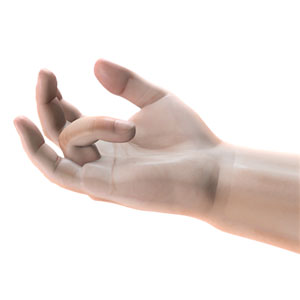What is Dupuytren’s Contracture/Disease?
Dupuytren’s Contracture is a hand condition in which underlying fibrous tissues thicken, causing the fingers to bend and contract inward. Patients with this condition are unable to fully straighten the affected fingers.
Dupuytren’s Disease, also commonly called Viking’s Disease, is caused from an excessive production of collagen deposited under the skin. It commonly occurs in the ring finger and little finger. Occasionally, the middle finger is affected while the thumb and index finger are rarely affected. Dupuytren’s contracture is a condition that usually progresses slowly over many years and is typically not painful.

What are Symptoms of Dupuytren’s Contracture?
The most commonly observed symptoms of Dupuytren’s contracture are lumps or nodules in the palm of the hand, difficulty in straightening the fingers, and contracture of the nodules which form tough bands called cords under the skin.
What are some Risk Factors of Dupuytren’s Contracture?
The cause of Dupuytren’s contracture is unknown. However, there are certain risk factors that may increase your chance of developing the condition. These can include the following:
- Heredity: The condition tends to run in families.
- Ancestry: Northern Europeans and people of Scandinavian descent are most commonly affected.
- Age: It occurs more frequently around age 60.
- Social Habits: Smoking and drinking alcohol may increase your risk of developing the condition.
- Medical Conditions: Patients with diabetes, alcoholism, cirrhosis of the liver, and seizure disorders appear to be at increased risk of developing the condition.
- Sex: The condition is more common in males than females.
How is Dupuytren’s Contracture Diagnosed?
Dupuytren’s contracture is diagnosed based on the patient’s history and physical examination. There are no special tests required. The physical examination may involve pressing on different parts of your hands and fingers to assess for hardened knots or tough bands of tissue/cords.
How is Dupuytren’s Contracture Treated?
You may not need treatment for Dupuytren’s contracture if the condition is not affecting your ability to perform daily activities. However, if you are having difficulty using your hands for everyday activities, your surgeon will recommend options to treat your condition. Treatment options will vary depending on the severity of the condition.
- Collagenase Injection(Xiaflex): An enzymatic drug that breaks down collagen can be injected into the corded tissue to soften and weaken the contracture. The physician then manipulates the area manually to break up the tissue. Xiaflexis the current FDA approved injectable in the United States. Please visit their website and ask your surgeon for more details to see if you are a potential candidate.
- Needle Aponeurotomy: This procedure involves inserting a small needle into the thickened palm tissue and manipulating it to loosen and break up the contracting tissue.
- Surgery: Your surgeon removes the thickened fibrous tissue causing the contracture.
Complications
Some of the complications include:
- Recurrence of the condition: Unfortunately, there is no cure for Dupuytren’s Disease, and it will always recur at varying rates.
- Stiffness
- Infection
- Nerve damage causing weakness, paralysis, or loss of feeling in the hand area
- Injury to the tendons of the fingers/hand
- Injury to the arteries of the fingers/hand
